Clock Tower:

While Rumi Darwaza reminds of the gateway in Turkey, Hussaianbad Clock was modelled as Big Ben Clock Tower, London. Overlooking Rumi Darwaza and Bada Imambara, the imposing structure has a height of 67 meters and is believed to be the tallest of all the clock towers in the country.
The Victorian and Gothic styled structure was built by Nawab Nasir-ud-Din Haider to welcome the first lieutenant governor of British, Sir George Cooper.
Dilkusha Palace:
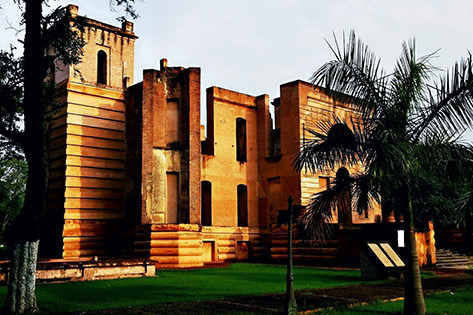
Sprawling gardens hold the ruins of this beautiful palace of heart’s delight, as its name means literally. The Baroque styled house was built by the British General Major Gore Ouseley for his friend Nawab Saadat Ali Khan as a hunting lodge initially, which later served as a summer resort as well.
Another example of replica, it resembled Seaton Delaval Hall in England. This palace of heart’s delight also became the victim of 1857 revolt alongwith The Residency and its neighbor La Martinere.
La Martinere College:
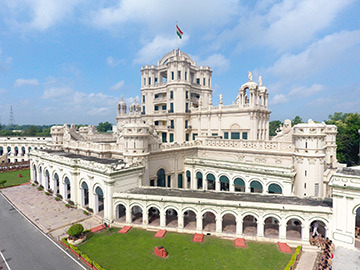
One of the best preserved colonial buildings in Lucknow, La Martinere College also served as siege of Lucknow like The Residency and Dilkusha Kothi, but only it had the fortune to remain in glory today as well. Originally built as a residence of French origin British Major Claude Martine, it was named La Constantia. The construction which started in 1795 completed in 07 years and in between he died in 1800. However, he had mentioned in his will to convert his house into educational institutions and to be named after him, and thus named as La Martinere College. He further wished to build 02 more institutions on similar lines in Kolkata and his birth place, Lyon with the wealth he left behind.
He was buried in the basements of the Constantia, which makes this complex on the banks of Gomti River as school and a mausoleum. It also makes this sprawling estate spread in 400 acres as the largest European funerary monument in India.
Stories from Dastarkhwaan:

The royal dining setting (Dastarkhwaan) of Nawabs saw the development of many lip - smacking delicacies. Inspired by Mughalai cuisine, what made Awadhi cuisine distinct is the cooking style. The chefs used Dum Pukt cooking or slow fire cooking enhanced with unique selection of spices. Nawabs’ love for the food can be gauged by the fact that royal chefs used to listen the Nawabs’ orders only and sometimes even Nawabs had to humbly request them to cook for their guests. Cooking was no lesser than an art for Nawabs and for that reason, there was a separate budget for the Royal Kitchens and different kitchens were tasked to serve the specialized cuisine on Nawab’s Dastarkhwaan on respective days. Infact, there used to be competitions among the chefs, and they kept enhancing their secret recipes to please the taste buds of Nawabs and win the rewards.
They even did not share the secret recipes of these dishes with their descendants and eventually most of them are lost today. Let’s share some interesting dishes and stories.
Kebabs:

Kebab’s found their way to Indian kitchen with the Mughals, but they got refined in Nawabs’ period. Their royal chefs experimented a lot to satisfy their masters’ taste buds. Variety of Kebabs cooked in Awadhi styled cooking stands out different than any other part of the country. Most sought after are Kakori kebab, Shami Kebab, Pasanda Kebab, Boti kebab and the most famous Galouti Kebab. There is very interesting story associated to origin of Galouti Kebab. With the growing age, Nawab Wajid Ali Shah lost his tooth but could not loose his love for Kebabs. One of his Royal chefs, Haji Murad Ali took the challenge and developed the kebabs mincing the lamb meat and made it tender using Papaya and cooked in patties form. These patties were made soft to the level that they melted in mouth.
Amazingly the chef was one handed (loosely called Tundey in local language) and later his son opened the restaurant named Tundey Kebabi, to continue satisfying the taste buds of generations. Today, the name Tundey kebabi is an iconic name and synonymous to Lucknow.
Biryani:
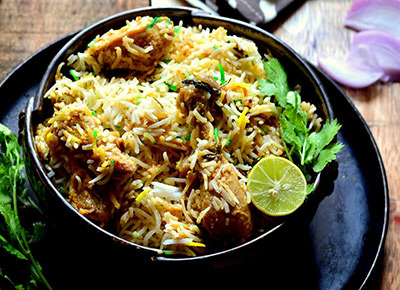
As Tundey Kebabi is synonymous to Lucknow, so is the Biryani to Hyderabad. But very few know that Awadh’s Biryani has different flavour and it is the cooking style, which makes it stand out different than in any other part of the country. Unlike other parts of the country, the rice and meat are initially cooked separately and then layered and slow cooked together in special utensils. Another characteristic, which makes this aromatic rice dish favored is the balanced use of spices, as in other dishes of Awadh. While Biryani was already popular among the Mughals, it found its way in Awadhi cuisines during the construction of Bara Imambara.
The Nawab felt the need of feeding the famine hit people of Awadh and ordered for the nutritional food to be cooked for masses. The Nawab found the dish so interesting that it was picked by his Royal kitchens to refine further for Nawab's Dastarkhwaan.
Nihari:

A meat stew used to be a traditional breakfast dish, which Mughals and Nawabs used to eat after Morning Prayer for its energy boosting properties, which made them stay fed until the afternoon prayers. .
It is another example of a slow cooked meal, where it is cooked whole night (minimum 06-08 hours) before being served in the morning.
Sheermal:
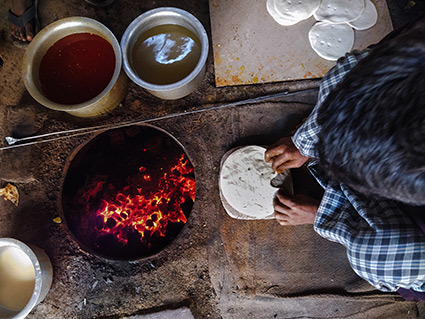
Be it any kebab or Nihari, it is best eaten with Kulchas (bread) and in Lucknow there is a large variety of breads from Naan to Rumali Roti (thin layred bread). However, Sheermal is more prominent for its unique preparation.
It is flat bread adorned with milk and saffron along with long list of ingredients. It found its way during the reign of nawab Nasiruddin Haider as a new variant of bread to be eaten with Nihari and today, there is a dedicated lane to it called Sheermal wali Gali.
Malai Pan:

Beetal Pan is quite famous from Nawabs’ time and remained favourite to them.
Amongst the many legends, Nawab Wajid Ali iShah wanted to get rid of his habit of chewing Tobacco pan and then one of the chefs attempted to make a pan of milk cream stuffed with dry fruits. It was similar to the texture of pan and Nawab liked that so much that he quit chewing Tobbacco pan. The innovator behind this delicacy was Ram Ashery and his shop is still sweetening the locals of Lucknow.
It is not that development and experimentation with delicacies stopped with the end of Nawab rule. The high demand for many local or street delicacies shows that the process continued thereafter as well. Some of them are Prakash ki Kulfi, Raja ki Thandai, Tokri Chaat at Royal café, cookies at Burma Bakery and Sharma ji ki chai with Ban Maska. These are some shops serving Lucknow generations after generations and need no introduction.
Handicrafts:

Handicrafts was another interest of Nawabs, and they patronized it especially Chikankari. Initially patronized by Mughals, Nawabs’ love for art made Awadh a major center of this form of art and even today, Lucknow is world renowned for this hand embroidery art. Also known as shadow work, the motifs of Chikankari are predominantly influenced by intricate carving patterns of Mughal architecture. This embroidery is done with white cotton thread on fine white cotton material. Traditionally, this embroidery was done on mulmul (fine muslin cotton) but due to non-availability of mulmul & also due to changing fashions & demand, now this work is mostly done on cotton, wool, chiffon, crepe, organde chiffon and silk clothes using contrast color threads.
While in Lucknow do checkout Indian dresses with beautiful Chikan embroidery to carry back with you as a souvenir.
Another form of embroidery which might interest you is Zardosi. This beautiful form of hand embroidery used silver & golden threads on satin or velvet fabrics. In addition to these threads, embellishments like beads, precious & semi - precious stones & pearls are also sewn. Take home some souvenirs with this form of embroidery to appreciate this art forever.
If by now, you have started wondering about the richness Lucknow possesses in terms of its history, monuments and delicious cuisine, we suggest to think again, as there is one more feather to its cap. Let us tell you. Its one of the eight classical dance forms of India - Kathak.
Kathak:

The name Kathak has been derived from the word Kathakar, which means storyteller. Traditionally, these Kathakars (storytellers) used to wander and communicate stories through dance, music, and song. Alongwith Jaipur and Varanasi, Lucknow was the place where it evolved and popularized.
Let us arrange an evening with nail biting Kathak performance exclusively for you. You will be amazed to see the beautiful use of facial expressions and eyebrows with eyes communicating the story.
Watch a strong Kathak performance in this video.
One city and so much interests. Doesn’t Lucknow sounds perfect destination for a vacation full of history, entertainment and a treat to taste buds along with eyes? There are many more stories waiting for you to be unfolded. We, at
Indo Asia Tours, are all about the handcrafted tours, memories, and moments you take out of your trip, and believe us, this escapade will be a life-changing one!

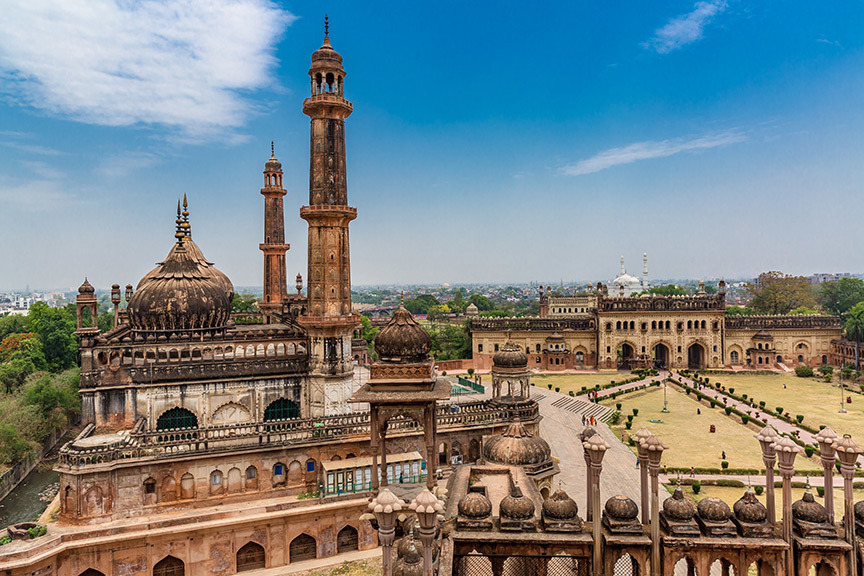
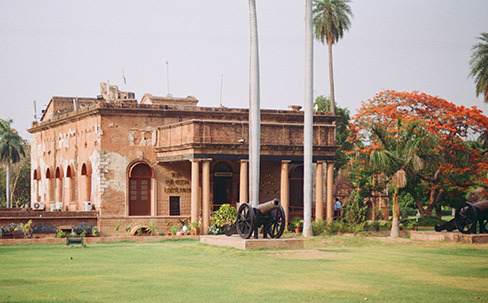
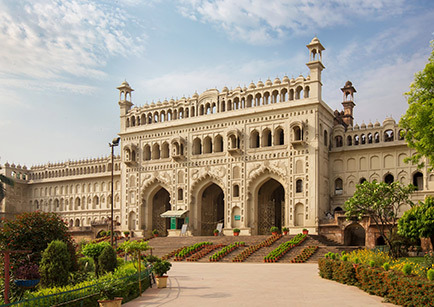 This is perhaps another important monument of Lucknow, as this was also the place which served as Nawab’s court. A grand entrance built in Mughal and Rajput style leads you to second grand entrance, welcoming you to this grand complex having Asifi mosque in the right, a step well on the left and Imambara in the middle. Believed to be the fifth largest mosque in the world, steps leading to the Asifi mosque grabs your attention. The architecture is so beautiful that its design makes the Mosque look greater than the size it is. The step well initially made to meet the water requirement for the construction of Imambara also helped the residents beat the heat in summers. The three storied Imambara is of course the center of attraction in the complex. The ground floor has halls which used to be the court of Nawab and the first and second floor has a maze called Bhool Bhulayia, which has around thousands of ways to enter but only two ways to come back. Isn’t it thrilling?. Before you manage to find the way to return, do not miss having a breathtaking view of the city, Gomti River and other structures in the vicinity. You would appreciate the engineering skills of those times, when we tell you that roof of this masterpiece has no girders or beams to support it, but just Lakhori bricks with interlocking technique. It’s not over yet, you will be amazed to hear the reason behind the construction of this beautiful structure. Once Lucknow was hit by famine and people were out of job and food. The then Nawab, Asaf ud Daulah tried helping them with some funds, but people did not want free lunches and asked for job. So, Nawab thought of constructing Bada Imambara to give job to people, but problem did not end here. The affluent class did not find it comfortable working with the lower class. Nawab came up with the solution where in Poor will work in the day and affluent will work in the night and their task was to demolish whatever faulty they find in that day’s construction. This delayed the finishing of construction, but perfection was matchless.
This is perhaps another important monument of Lucknow, as this was also the place which served as Nawab’s court. A grand entrance built in Mughal and Rajput style leads you to second grand entrance, welcoming you to this grand complex having Asifi mosque in the right, a step well on the left and Imambara in the middle. Believed to be the fifth largest mosque in the world, steps leading to the Asifi mosque grabs your attention. The architecture is so beautiful that its design makes the Mosque look greater than the size it is. The step well initially made to meet the water requirement for the construction of Imambara also helped the residents beat the heat in summers. The three storied Imambara is of course the center of attraction in the complex. The ground floor has halls which used to be the court of Nawab and the first and second floor has a maze called Bhool Bhulayia, which has around thousands of ways to enter but only two ways to come back. Isn’t it thrilling?. Before you manage to find the way to return, do not miss having a breathtaking view of the city, Gomti River and other structures in the vicinity. You would appreciate the engineering skills of those times, when we tell you that roof of this masterpiece has no girders or beams to support it, but just Lakhori bricks with interlocking technique. It’s not over yet, you will be amazed to hear the reason behind the construction of this beautiful structure. Once Lucknow was hit by famine and people were out of job and food. The then Nawab, Asaf ud Daulah tried helping them with some funds, but people did not want free lunches and asked for job. So, Nawab thought of constructing Bada Imambara to give job to people, but problem did not end here. The affluent class did not find it comfortable working with the lower class. Nawab came up with the solution where in Poor will work in the day and affluent will work in the night and their task was to demolish whatever faulty they find in that day’s construction. This delayed the finishing of construction, but perfection was matchless.
 A little walk away, Chotta Imambara is another masterpiece. Although not as grand as the Bara Imambara in size, it is worth visiting for beautiful structure. Exteriors are decorated with versus of Quran written in calligraphy while interiors are unexpectedly decorated with colorful Chandeliers. A blend of Persian and Indo-Islamic architecture it is adorned by the stream running in front of the Imambara.
A little walk away, Chotta Imambara is another masterpiece. Although not as grand as the Bara Imambara in size, it is worth visiting for beautiful structure. Exteriors are decorated with versus of Quran written in calligraphy while interiors are unexpectedly decorated with colorful Chandeliers. A blend of Persian and Indo-Islamic architecture it is adorned by the stream running in front of the Imambara.
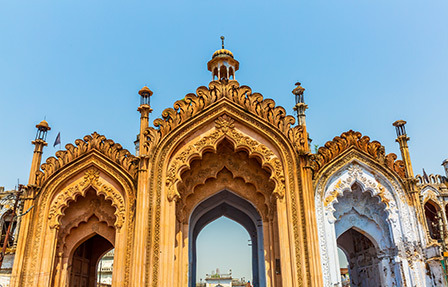 The Gateway was also a part of the relief work initiated by Nawab Asad ud daula to help the people in famine. Standing majestically between Bara Imambara and Chhota Imambara, the beauty of this gateway is that if seen from the gate of Bara Imambara, it resembles to any Rajput palace and if seen from the entrance of Chotta Imambara, it looks like a double arched gateway.
The Gateway was also a part of the relief work initiated by Nawab Asad ud daula to help the people in famine. Standing majestically between Bara Imambara and Chhota Imambara, the beauty of this gateway is that if seen from the gate of Bara Imambara, it resembles to any Rajput palace and if seen from the entrance of Chotta Imambara, it looks like a double arched gateway.
 While Rumi Darwaza reminds of the gateway in Turkey, Hussaianbad Clock was modelled as Big Ben Clock Tower, London. Overlooking Rumi Darwaza and Bada Imambara, the imposing structure has a height of 67 meters and is believed to be the tallest of all the clock towers in the country.
While Rumi Darwaza reminds of the gateway in Turkey, Hussaianbad Clock was modelled as Big Ben Clock Tower, London. Overlooking Rumi Darwaza and Bada Imambara, the imposing structure has a height of 67 meters and is believed to be the tallest of all the clock towers in the country.
 Sprawling gardens hold the ruins of this beautiful palace of heart’s delight, as its name means literally. The Baroque styled house was built by the British General Major Gore Ouseley for his friend Nawab Saadat Ali Khan as a hunting lodge initially, which later served as a summer resort as well.
Sprawling gardens hold the ruins of this beautiful palace of heart’s delight, as its name means literally. The Baroque styled house was built by the British General Major Gore Ouseley for his friend Nawab Saadat Ali Khan as a hunting lodge initially, which later served as a summer resort as well.
 One of the best preserved colonial buildings in Lucknow, La Martinere College also served as siege of Lucknow like The Residency and Dilkusha Kothi, but only it had the fortune to remain in glory today as well. Originally built as a residence of French origin British Major Claude Martine, it was named La Constantia. The construction which started in 1795 completed in 07 years and in between he died in 1800. However, he had mentioned in his will to convert his house into educational institutions and to be named after him, and thus named as La Martinere College. He further wished to build 02 more institutions on similar lines in Kolkata and his birth place, Lyon with the wealth he left behind.
One of the best preserved colonial buildings in Lucknow, La Martinere College also served as siege of Lucknow like The Residency and Dilkusha Kothi, but only it had the fortune to remain in glory today as well. Originally built as a residence of French origin British Major Claude Martine, it was named La Constantia. The construction which started in 1795 completed in 07 years and in between he died in 1800. However, he had mentioned in his will to convert his house into educational institutions and to be named after him, and thus named as La Martinere College. He further wished to build 02 more institutions on similar lines in Kolkata and his birth place, Lyon with the wealth he left behind.
 The royal dining setting (Dastarkhwaan) of Nawabs saw the development of many lip - smacking delicacies. Inspired by Mughalai cuisine, what made Awadhi cuisine distinct is the cooking style. The chefs used Dum Pukt cooking or slow fire cooking enhanced with unique selection of spices. Nawabs’ love for the food can be gauged by the fact that royal chefs used to listen the Nawabs’ orders only and sometimes even Nawabs had to humbly request them to cook for their guests. Cooking was no lesser than an art for Nawabs and for that reason, there was a separate budget for the Royal Kitchens and different kitchens were tasked to serve the specialized cuisine on Nawab’s Dastarkhwaan on respective days. Infact, there used to be competitions among the chefs, and they kept enhancing their secret recipes to please the taste buds of Nawabs and win the rewards.
The royal dining setting (Dastarkhwaan) of Nawabs saw the development of many lip - smacking delicacies. Inspired by Mughalai cuisine, what made Awadhi cuisine distinct is the cooking style. The chefs used Dum Pukt cooking or slow fire cooking enhanced with unique selection of spices. Nawabs’ love for the food can be gauged by the fact that royal chefs used to listen the Nawabs’ orders only and sometimes even Nawabs had to humbly request them to cook for their guests. Cooking was no lesser than an art for Nawabs and for that reason, there was a separate budget for the Royal Kitchens and different kitchens were tasked to serve the specialized cuisine on Nawab’s Dastarkhwaan on respective days. Infact, there used to be competitions among the chefs, and they kept enhancing their secret recipes to please the taste buds of Nawabs and win the rewards.
 Kebab’s found their way to Indian kitchen with the Mughals, but they got refined in Nawabs’ period. Their royal chefs experimented a lot to satisfy their masters’ taste buds. Variety of Kebabs cooked in Awadhi styled cooking stands out different than any other part of the country. Most sought after are Kakori kebab, Shami Kebab, Pasanda Kebab, Boti kebab and the most famous Galouti Kebab. There is very interesting story associated to origin of Galouti Kebab. With the growing age, Nawab Wajid Ali Shah lost his tooth but could not loose his love for Kebabs. One of his Royal chefs, Haji Murad Ali took the challenge and developed the kebabs mincing the lamb meat and made it tender using Papaya and cooked in patties form. These patties were made soft to the level that they melted in mouth.
Kebab’s found their way to Indian kitchen with the Mughals, but they got refined in Nawabs’ period. Their royal chefs experimented a lot to satisfy their masters’ taste buds. Variety of Kebabs cooked in Awadhi styled cooking stands out different than any other part of the country. Most sought after are Kakori kebab, Shami Kebab, Pasanda Kebab, Boti kebab and the most famous Galouti Kebab. There is very interesting story associated to origin of Galouti Kebab. With the growing age, Nawab Wajid Ali Shah lost his tooth but could not loose his love for Kebabs. One of his Royal chefs, Haji Murad Ali took the challenge and developed the kebabs mincing the lamb meat and made it tender using Papaya and cooked in patties form. These patties were made soft to the level that they melted in mouth.
 As Tundey Kebabi is synonymous to Lucknow, so is the Biryani to Hyderabad. But very few know that Awadh’s Biryani has different flavour and it is the cooking style, which makes it stand out different than in any other part of the country. Unlike other parts of the country, the rice and meat are initially cooked separately and then layered and slow cooked together in special utensils. Another characteristic, which makes this aromatic rice dish favored is the balanced use of spices, as in other dishes of Awadh. While Biryani was already popular among the Mughals, it found its way in Awadhi cuisines during the construction of Bara Imambara.
As Tundey Kebabi is synonymous to Lucknow, so is the Biryani to Hyderabad. But very few know that Awadh’s Biryani has different flavour and it is the cooking style, which makes it stand out different than in any other part of the country. Unlike other parts of the country, the rice and meat are initially cooked separately and then layered and slow cooked together in special utensils. Another characteristic, which makes this aromatic rice dish favored is the balanced use of spices, as in other dishes of Awadh. While Biryani was already popular among the Mughals, it found its way in Awadhi cuisines during the construction of Bara Imambara.
 A meat stew used to be a traditional breakfast dish, which Mughals and Nawabs used to eat after Morning Prayer for its energy boosting properties, which made them stay fed until the afternoon prayers. .
A meat stew used to be a traditional breakfast dish, which Mughals and Nawabs used to eat after Morning Prayer for its energy boosting properties, which made them stay fed until the afternoon prayers. .
 Be it any kebab or Nihari, it is best eaten with Kulchas (bread) and in Lucknow there is a large variety of breads from Naan to Rumali Roti (thin layred bread). However, Sheermal is more prominent for its unique preparation.
Be it any kebab or Nihari, it is best eaten with Kulchas (bread) and in Lucknow there is a large variety of breads from Naan to Rumali Roti (thin layred bread). However, Sheermal is more prominent for its unique preparation.
 Beetal Pan is quite famous from Nawabs’ time and remained favourite to them.
Beetal Pan is quite famous from Nawabs’ time and remained favourite to them.
 Handicrafts was another interest of Nawabs, and they patronized it especially Chikankari. Initially patronized by Mughals, Nawabs’ love for art made Awadh a major center of this form of art and even today, Lucknow is world renowned for this hand embroidery art. Also known as shadow work, the motifs of Chikankari are predominantly influenced by intricate carving patterns of Mughal architecture. This embroidery is done with white cotton thread on fine white cotton material. Traditionally, this embroidery was done on mulmul (fine muslin cotton) but due to non-availability of mulmul & also due to changing fashions & demand, now this work is mostly done on cotton, wool, chiffon, crepe, organde chiffon and silk clothes using contrast color threads.
Handicrafts was another interest of Nawabs, and they patronized it especially Chikankari. Initially patronized by Mughals, Nawabs’ love for art made Awadh a major center of this form of art and even today, Lucknow is world renowned for this hand embroidery art. Also known as shadow work, the motifs of Chikankari are predominantly influenced by intricate carving patterns of Mughal architecture. This embroidery is done with white cotton thread on fine white cotton material. Traditionally, this embroidery was done on mulmul (fine muslin cotton) but due to non-availability of mulmul & also due to changing fashions & demand, now this work is mostly done on cotton, wool, chiffon, crepe, organde chiffon and silk clothes using contrast color threads.
 The name Kathak has been derived from the word Kathakar, which means storyteller. Traditionally, these Kathakars (storytellers) used to wander and communicate stories through dance, music, and song. Alongwith Jaipur and Varanasi, Lucknow was the place where it evolved and popularized.
The name Kathak has been derived from the word Kathakar, which means storyteller. Traditionally, these Kathakars (storytellers) used to wander and communicate stories through dance, music, and song. Alongwith Jaipur and Varanasi, Lucknow was the place where it evolved and popularized.
 Thank you, patrons, for reposing faith in our destinations and enquiring for customised virtual destination awareness training programs. We are proud to conduct them successfully so far and are looking forward to hold similar virtual destination awareness training programs for your team or yourself or a virtual tour for your clients. Let us know the destination of your interest along with your convenient date / time and we will be happy to set up a program for you.
Thank you, patrons, for reposing faith in our destinations and enquiring for customised virtual destination awareness training programs. We are proud to conduct them successfully so far and are looking forward to hold similar virtual destination awareness training programs for your team or yourself or a virtual tour for your clients. Let us know the destination of your interest along with your convenient date / time and we will be happy to set up a program for you.






